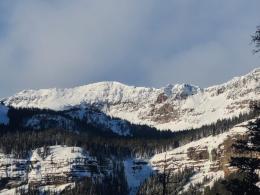Good morning. This is Dave Zinn with the Gallatin National Forest Avalanche Forecast on Thursday, February 22nd at 7:15 a.m. Today’s forecast is sponsored by Yellowstone Club Community Foundation and Montana State Parks. This forecast does not apply to operating ski areas.
Mountain temperatures are in the teens to low 20s F this morning, with 5-15 mph winds from the northwest to southwest. There is no new snow. Today, temperatures will be in the upper 20s to low 30s F with 5-15 mph winds from the west to southwest. The southern portion of the advisory area may get a trace to 1” of new snow by tomorrow morning.
Dangerous avalanche conditions exist in the mountains south of Bozeman through Island Park and Cooke City. Human-triggered avalanches are likely. Yesterday was one of two days since January 4, with no avalanche activity or red flags of instability recorded in our weather and avalanche log. On many days during this month-and-a-half period, the log overflowed with activity. While yesterday's inactivity is encouraging, receiving fewer observations on the Wednesday after a holiday weekend is hardly surprising.
Persistent weak layers buried 2-4 feet deep are the culprit for the widespread and consistent instability. This weekend, backcountry travelers reported many human-triggered and natural avalanches across the advisory area; there were close calls, and a rider deployed their airbag when they got caught in a slide in the Taylor Fork (details). Thankfully everyone walked away. Review the dozens of avalanches, stomach-dropping collapses, and shooting cracks in recent entries to the avalanche activity log. Traveling on slopes steeper than 30 degrees is dangerous, as is traveling immediately below steep terrain due to concerns about remotely triggering avalanches from below or nearby areas, as Doug and Alex experienced near Cedar Mountain on Saturday (use the 20-30 Rule).
Make a travel plan recreate on slopes 30 degrees or less as we impatiently wait for stability to improve and diligently stick with that plan while you are in the backcountry (Cooke City video, Bacon Rind video).
The danger is rated CONSIDERABLE.
Human-triggered avalanches are possible in the Bridger Range. Two large avalanches failed this weekend on Bridger Peak and south of Saddle Peak, and the snowpack structure is weak. However, we have generally observed less recent avalanche activity and fewer signs of instability, such as collapsing and shooting cracks in the Bridger Range than the rest of the advisory area. If you are considering stepping into steeper terrain, Ian wisely advised an incremental approach rather than jumping in headfirst (video). Tiptoe into lower-angle avalanche terrain while avoiding high-consequence areas with terrain traps or recent wind-loading (i.e., Saddle Peak, where there was recent avalanche activity).
Evaluate the snowpack by testing for instability and carefully consider terrain choices working to avoid features of concern before proceeding. Watch for signs of limited wet snow instability in south-facing terrain during the heat of the day.
The danger is rated MODERATE.
If you venture out, please fill an observation form. It does not need to be technical. Did you see any avalanches? How much snow is on the ground? Was the wind moving snow? Simple observations are incredibly valuable. You can also contact us via email (mtavalanche@gmail.com), phone (406-587-6984), or Instagram (#gnfacobs).
Upcoming Avalanche Education and Events
Our education calendar is full of awareness lectures and field courses. Check it out: Events and Education Calendar.
Friday evening and Saturday, February 23 and 24. Companion Rescue Course. More information and registration HERE.
Every weekend in Cooke City: Friday at The Antlers at 7 p.m., Free Avalanche Awareness and Current Conditions talk, and Saturday from 10 a.m.-2 p.m. at Round Lake Warming Hut, Free Rescue Practice.
Loss in the Outdoors is a support group for those affected by loss and grief related to outdoor pursuits. Check out the link for more information.
A recent article, As radio use spreads in backcountry, so do community channels, describes the benefits of communicating amongst groups in heavily trafficked areas.



